Setting Up Network Printing with IntranetWare Client for Windows NT Workstation
Articles and Tips: article
Support Engineer
Novell Technical Services
BRENT HEGERHORST
Software Engineer
Distributed Networks Business Unit
01 May 1997
The IntranetWare Client for Windows NT supports the native NT "deviceless" printing as well as "point-and-print" to simplify printer setup for users. Find out how to make this all work in this AppNote on network printing.
- Introduction
- Installing a Printer with the Add Printer Wizard
- Printing to a Network Printer
- Configuring an Installed Printer
- Using Point-and-Print for Network Printers
- Conclusion
Introduction
Like Windows 95, Windows NT 4.0 Workstation supports "deviceless" printing. In other words, it is no longer necessary to associate an LPT port with a specific printer and use a print capture to redirect the output to a network printer. Instead, GUI applications send print data directly to a Windows NT printer device (such as a NetWare print queue), which points to a network printer. Windows NT writes the printer configuration information to the Registry.
To support printing from MS-DOS or Windows 3.x applications, you can still set up an LPT port capture and redirect output to the network printer specified in the capture. Captures are globalCif you do a capture at an MS-DOS prompt, the capture exists under the GUI; if you do a capture in the GUI world, it exists for MS-DOS boxes. However, any flags you set up under a DOS capture cannot be translated into the GUI world. There's no way to associate a Windows NT printer device with an LPT port.
The IntranetWare Client for Windows NT also supports "point-and-print" to simplify printer setup for users. Point-and-print allows you to store the print driver files for a network printer in a publicly-accessible network directory. When users want to use the printer, they can install it quickly without having to know the printer manufacturer/model and the location of the print driver.
This AppNote covers the following aspects of setting up network printing:
IntranetWare Client for Windows NT printing theory of operations
Installing a network printer and its associated driver with the Windows NT 4.0 Add Printer Wizard
Printing to a network printer
Configuring an installed network printer
Setting up point-and-print for network printers
Installing a Printer with the Add Printer Wizard
Because it uses the Windows 95 interface, Windows NT 4.0 provides the Add Printer wizard to simplify the process of installing printers. The Printers folder acts as a central place for running the wizard and managing printing processes.
Below are the steps for installing a network printer using the Add Printer Wizard in Windows NT 4.0 workstation. These instructions assume a NetWare print queue (Bindery or NDS) has already been created for the printer.
In Windows NT 4.0 workstation, open the Printers folder. You can do this in one of the following ways:
From the Start menu, point to Settings, and then click on Printers.
In My Computer, double-click on the Printers folder.
In Control Panel, double-click on the Printers folder.
The Printers folder contains icons for any printers that are already installed, plus an Add Printer icon, as shown in Figure 1.
Figure 1: The Printers folder.
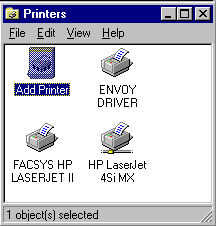
Double-click on the Add Printer icon to launch the Add Printer Wizard.
The next window (see Figure 2) asks whether the printer will be managed by your computer (a local printer) or if you want to connect to a printer attached to another computer (a network or "remote" printer). The only difference between installing a remote printer and a local printer with the Add Printer Wizard is that you must specify the path to the remote printer.
Figure 2:Choose whether the printer will be managed by your computer or by a network print server.
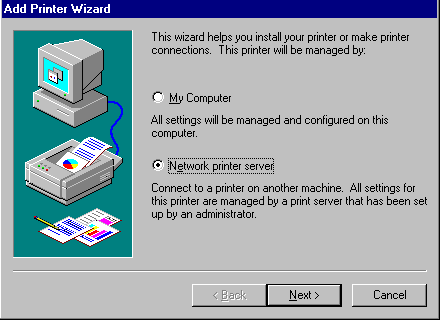
For this example, assume you are installing a network printer. Select "Network printer server" and click on Next.
Note: With the Windows 95 Print Wizard you have an option to Print fromMS-DOS-based applications. With Windows NT you do not havethis option. If you need to print from MS-DOS-based applications,you will need to capture the printer port manually or froma login script.
Since you have selected a network printer, you need to specify the path to the print queue that has been set up for the printer. You can either type in the UNC path or walk the IntranetWare Network or Novell Directory Services tree to find the network printer resource (see Figure 3).
Figure 3: The Connect to Printer window.
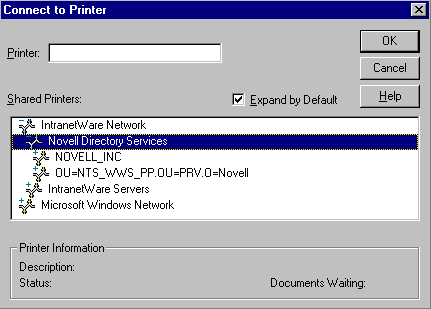
When the selected print queue appears in the Printer entry box, click on OK to continue. In the example shown in Figure 4, the queue has been entered as a UNC path.
Figure 4: The Connect to Printer window with path to printer.
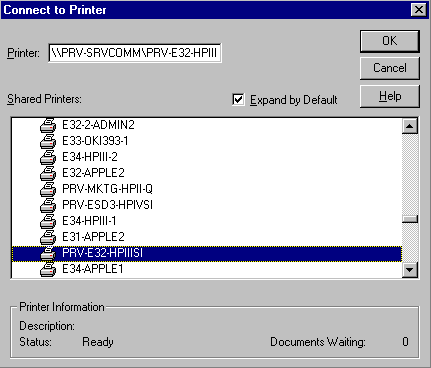
If the print driver for the selected printer is not available, you will see the message shown in Figure 5. Click on OK to install the print driver.
Figure 5: No driver installed message.

In the window shown in Figure 6, choose the manufacturer and the type of printer you are installing. The example shows the selection of an HP LaserJet III Si non-PostScript printer from Hewlett-Packard. (If the printer is not listed but you have a Windows NT driver for it, click on the Have Disk.... button and follow the on-screen instructions).
Figure 6: The Connect to Printer window with path to printer.
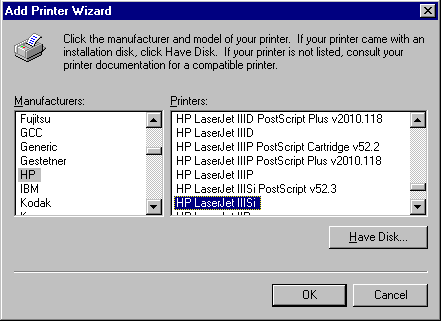
Click on OK.
Follow the prompts to insert the Windows NT CD, or provide an alternate path to the driver file. When the network printer has been successfully installed, you will see the message displayed in Figure 7.
Figure 7: The message displayed when the printer has been successfully installed.
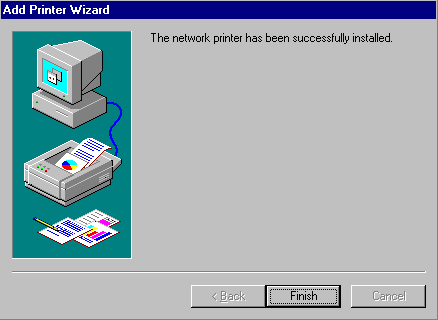
Click on Finish.
An icon for the newly-installed printer should now appear in the Printers folder, as shown in Figure 8.
Figure 8: The icon for the newly installed printer.

Printing to a Network Printer
You can print two different ways: from within an application, or using a printer shortcut.
Printing from Within an Application
You can print from within an application in Windows NT in the same manner as with Windows 95 or Windows 3.x. The only noticeable difference in the print dialog between Windows NT/95 and Windows 3.x is the absence of an LPT port in the "Current Printer" designation, as you can see in the example Print dialog box from WordPerfect for Windows (see Figure 9).
Figure 9: The Print dialog box in a Windows application.
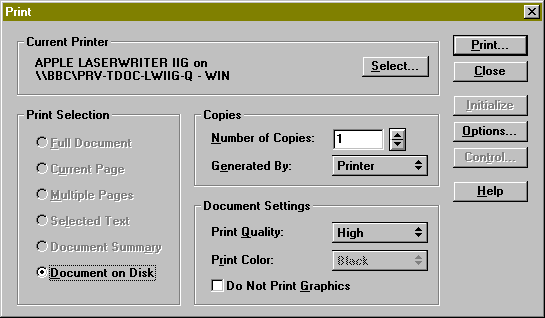
Printing Using a Shortcut
In Windows NT, "shortcuts" allow you to copy an icon that relates to any program, document, or printer and move the icon to the desktop or to another folder for quick access to frequently used resources. For example, you can create a printer shortcut icon and place it on the desktop for easier access.
Once a printer shortcut is set up, you can simply drag and drop a file onto the printer shortcut icon. The shortcut will automatically open the associated application and execute the print command.
Configuring an Installed Printer
To configure the printer after it is installed, right-click on the printer's icon in the Printers folder. The resulting menu lists several options for the printer, as shown in Figure 10.
Figure 10: The menu of options for a printer.
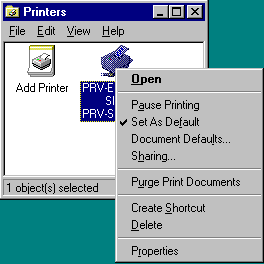
These pull-down menu options are defined as follows:
|
Option |
Description |
|
Open |
Opens the printer's print queue and displays current print jobs |
|
Pause Printing |
Stores print jobs until the printer is turned online by clicking the Pause Printing option again. If the printer is a network printer, you need permissions to modify this setting. |
|
Set As Default |
Makes the selected printer the default printer |
|
Document Defaults |
Stores default settings. This option allows you to set paper size, paper sources, number of copies, and other options to change and set as defaults. |
|
Sharing |
Allows the sharing of a printing device |
|
Purge Print Documents |
Removes stored print jobs from the printer's queue |
|
Create Shortcut |
Creates a shortcut icon for the printer |
|
Delete |
Deletes the printer definition |
|
Properties |
Sets printer properties and allows you to capture a printer |
|
Note: With Windows NT, you cannot rename the printer object as you could in Windows 95 if it is a network printer. |
Below are some examples of what you can do with these options. The examples assume you are working from the Printers folder. Many of these same tasks can also be performed by right-clicking on printers and print queues that are viewed in Explorer or Network Neighborhood.
Displaying Jobs in a Print Queue
To see jobs in a print queue, select "Open" from the pull-down menu. This opens the print queue and displays the current print jobs, as shown in Figure 11.
Figure 11: The print queue display window.

|
Note: You can access this same queue window by double-clicking on the printer icon in the Printersfolder, or on the print queue in Explorer or Network Neighborhood. |
Modifying Printer Properties
To change the properties associated with the printer, select Properties from the menu. From here you can configure general printer settings, ports, scheduling, sharing security, IntranetWare settings, and device settings.
The General Tab. This page displays general information about the printer, such as its physical location, a descriptive comment, and the printer driver installed. You can also add or customize a separator page, select a vendor-supplied print processor, and print a test page (see Figure 12).
Figure 12: The General tab in the printer properties window.
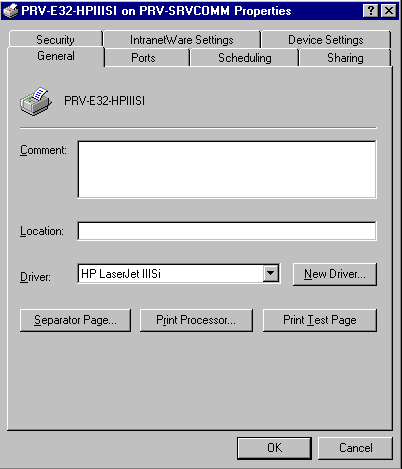
The separator page, also called a header or banner page, prints before each print job. The separator page typically identifies the computer on which the job was created, the time it was created, and so on. You can click on Separator Page... to customize this information.
You can click on Print Test Page to send a test page to the printer for troubleshooting purposes.
The Ports Tab. Clicking on this tab displays the computer's physical ports (LPT and COM ports) and logical ports (FILE and network print queues), as shown in Figure 13. The Description column lists the associated port monitor, such as Local Port. The Printers column lists the printers that use each port. You can set up a printer pool, which is two or more identical printers associated with one logical printer. To do this, check the Enable Printer Pooling box and then select multiple ports.
Figure 13: The Ports page in the printer properties window.
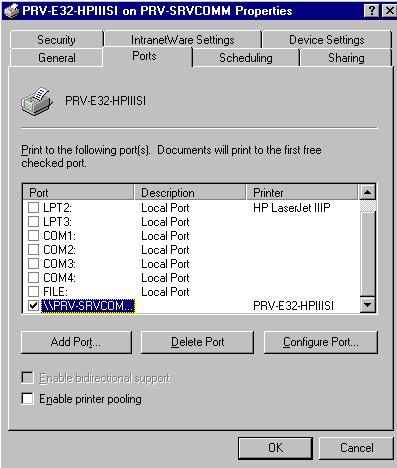
You can also add, configure, and delete virtual ports, such as network print queues, file destinations, and so on. To add a new port to the list, for example, click on on the Add Port... button and select the type of port monitor you want (see Figure 14).
Figure 14: The Printer Ports window.
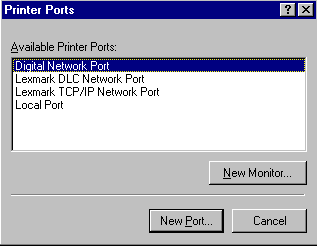
The Scheduling Tab. This page displays the times the printer is available, its priority level, and various spooling options (see Figure 15).
Figure 15: The Scheduling tab in the printer properties window.
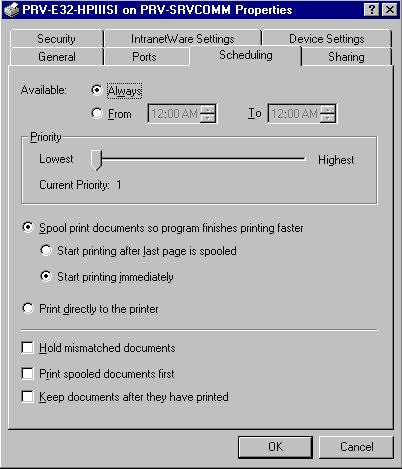
The Available selection allows you to configure the printer for continuous 24-hour availability or restrict the hours it will be available. The Priority selection sets the default document priority for the printer. Higher-priority documents will print before lower-priority documents.
By default, documents are spooled before being printed. Spooling is the process of writing the print job to the hard disk before sending it to the printer. As soon as the print job is fully written to disk, the user can continue working while the spooler sends the document to the printer in the background.
Check the online help for descriptions of the other spooling options available on the Scheduling page.
The Security Tab. Clicking on the Security tab takes you to the page shown in Figure 16.
Figure 16: The Connect to Printer window with path to printer.
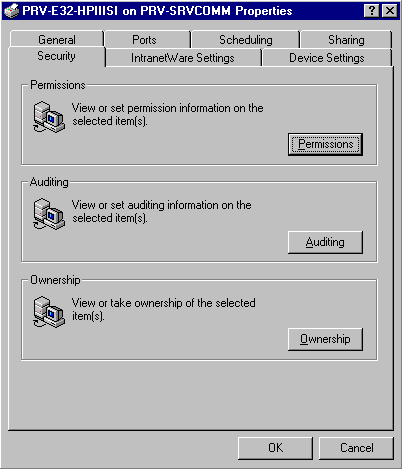
The Permissions button lets you set the level of printer access for users or groups. The choices for access include No Access, Print, Manage Documents, and Full Control.
The Auditing button lets you set up printing events to be tracked for different users or groups that are allowed to use the printer. Events you can track include printing, deleting, changing permissions, and taking ownership. The Windows NT Audit Policy must have auditing turned on for this to work.
The Ownership button displays the printer's owner. If you have the proper permissions, you can take ownership of the printer.
The Device Settings Tab. This page displays everything from paper tray sizes to font substitutions table for that printer (see Figure 17). You can use it to download soft fonts, install font cartridges, increase printer virtual memory, and so on.
Figure 17: The Connect to Printer window with path to printer.
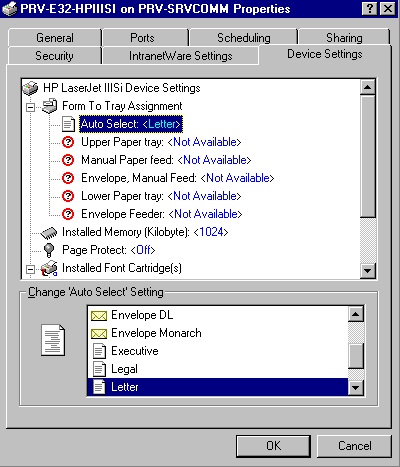
Use the online help if you need a description of these settings for your particular printer. Additional information may be available in your printer's user manual.
The IntranetWare Settings Tab. Clicking on the IntranetWare Settings tab brings up the page shown in Figure 18. From here you can access the usual NetWare capture parameters, such as banner page and form feed options.
Figure 18: The IntranetWare Settings page in the printer properties window.
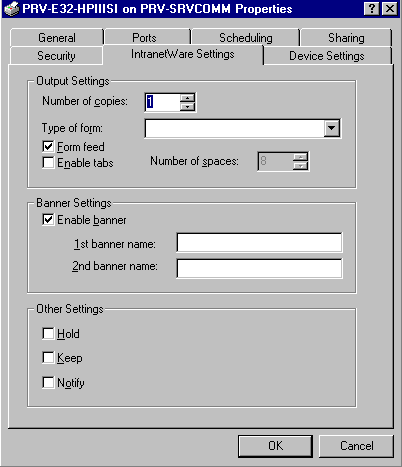
Printing from DOS Applications
To set up a printer to print from DOS applications, you can make capture settings in the same way as for previous NetWare clients. Right-click on Network Neighborhood and select Capture Printer Port from the resulting menu. Or select a printer in Network Neighborhood, right-click on the print queue, and select Capture Printer Port. You will see the Capture Printer Port dialog box shown in Figure 19.
Figure 19: The Capture Printer Port dialog box.
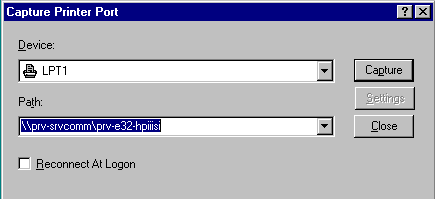
Enter the path of the printer device (server and print queue). If you want to recapture the printer port upon logon, check the Reconnect At Logon button. Click on the Capture button to initiate the capture. To make changes to the capture settings, click on the Settings button. You will see a window similar to the one shown in Figure 20.
Figure 20: The Capture settings page.
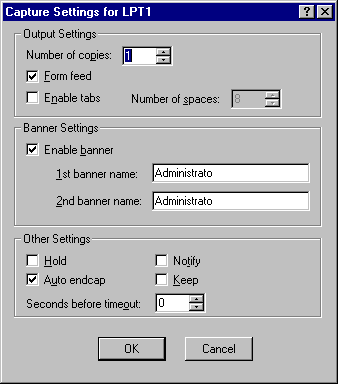
To check the current capture settings, go to a DOS box and issue the CAPTURE SHcommand.
Using Point-and-Print for Network Printers
Point-and-print simplifies the process of installing a network printer for Windows NT users. With the IntranetWare Client for Windows NT, the network administrator can configure a printer so that a user can simply "point" to the printer or queue and Windows NT will retrieve printer-specific information from the network, including:
The printer manufacturer and model
The printer driver
The name of the server on which the printer driver files are stored
From this information, it can be determined which driver to retrieve from a public directory on the server and copy to the Windows NT workstation.
You can use point-and-print for either Bindery or NDS printers and print queues. The printer driver files are stored in the NetWare bindery or in the NetWare Directory via extending the NDS schema.
Setting Up a Network Printer for Point-and-Print
To set up point-and-print for a network printer and store the printer information on a NetWare 3.x or 4.x server, complete these steps.
Start Windows NT and log in to an NDS tree or NetWare server as Admin/ Supervisor or equivalent user. (This should be the tree or server where you want the path to the printer driver files to be located.)
In Network Neighborhood, browse the network until you find the NetWare printer or print queue you want to set up. Right-click on the queue and select Properties from the resulting menu (see Figure 21).
Figure 21: The menu of options for a print queue.
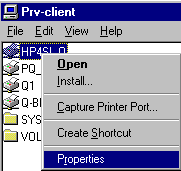
In the print queue properties window, click on the "Setup Point and Print" tab. (This tab only appears if you have logged in as Admin/Supervisor or equivalent.) A page similar to the one shown in Figure 22 is displayed.
Specify the path for downloading the printer driver files. (You must be logged in to the tree or server where the path is located and have sufficient rights to copy files to the specified directory.) It is recommended that you choose the preferred (default) path by checking the Use Preferred Path box. The default path is SYS:PUBLIC \nt40\drivers. If you don't want to use this path, uncheck the box and type another UNC path in the entry box (for example:\\prv-client\sys\driver).
Figure 22: The Setup Point and Print page.
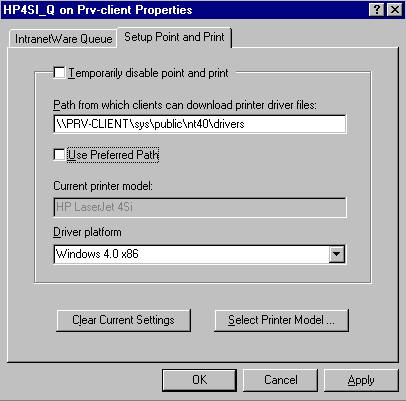
Click on the Select Printer Model button and select your printer maufacturer and model from the lists provided in the Select Device dialog box, as shown in Figure 23.
Figure 23: The Manufacturer and Printer lists.
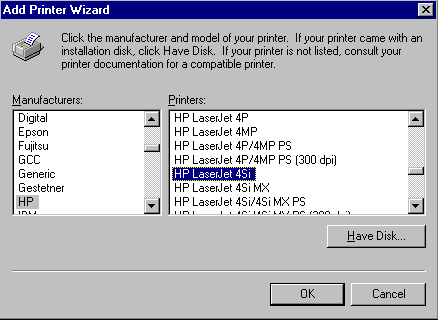
Click on OK. The appropriate printer driver files will be copied to the directory specified in Step 4.
After the driver files are copied, click on OK to close the point-and-print setup window.
Users will need at least Read and File Scan rights to the path specified in Step 4. Since all users have these rights in the SYS:PUBLIC directory, you do not need to grant any additional rights if you use the preferred path or any subdirectory of SYS:PUBLIC. If you specify a different directory for the Windows NT print driver files, you will need to grant the rights explicitly.
If you later change the path for the printer driver files, you must reselect the printer model. Printer-specific settings such as paper size are not retrievable for a NetWare print queue. You'll have to adjust these printer settings manually after the printer is installed on the Windows NT workstation.
Installing a Printer with Point-and-Print
To use point-and-print to install a NetWare printer, users should follow these steps:
Choose one of the methods below to "point" to the printer you want to install and launch the Add Printer Wizard:
In Network Neighborhood, double-click on the NetWare server icon for the server containing the desired print queue. Drag and drop the print queue into the Printers folder.
In Network Neighborhood, double-click on the desired print queue.
In Network Neighborhood, highlight the desired print queue and select File | Open from the pull-down menus.
From the Printers folder, start the Add Printer Wizard by double-clicking on the Add Printer icon.
Follow the instructions in the Add Printer Wizard as it prompts you to set up the printer. The steps are basically the same as described earlier in this AppNote, except that you don't need to select the printer manufacturer and model. Windows NT will automatically copy the files for the printer driver (including .DRV, .DLL, .HLP, and other files, as needed) to the WINDOWS\SYSTEM directory.
Conclusion
Once you have printing set up properly for IntranetWare Client for Windows NT 4.0 workstations, users should be able to print to network printers as easily as to locally-attached printers. For more information about the IntranetWare Client and printing, refer to the online help.
* Originally published in Novell AppNotes
Disclaimer
The origin of this information may be internal or external to Novell. While Novell makes all reasonable efforts to verify this information, Novell does not make explicit or implied claims to its validity.